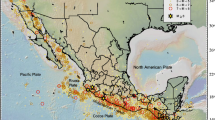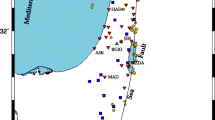Abstract
— Regional seismic discriminants for the May 11, 1998 Indian underground nuclear test(s) and earthquakes recorded at station NIL (Nilore, Pakistan) provide new data to test strategies that can be used to monitor the Comprehensive Nuclear-Test-Ban Treaty (CTBT). Three categories of regional discriminants (ratios of P- and/or S-wave energy) were measured on short-period (0.5–6 Hz) seismograms: P/S amplitude ratios (phase ratios) measured in the same frequency band, P- and S-wave spectral ratios (i.e., low frequency to high frequency for the same phase) and P/S cross-spectral ratios (i.e., low frequency S-wave to high frequency P-wave). The P/S amplitude ratios show good separation of the Indian nuclear test and regional earthquakes for Pn/Lg and Pn/Sn, however Pg/Lg does not discriminate as well. Pn/Lg and Pn/Sn discriminate well at frequencies as low as 0.5–2 Hz, especially after accounting for path effects. This observation differs from previous studies that report poor separation of earthquakes and explosions at lower frequencies. The P/S amplitude ratios do not show any magnitude dependence, suggesting that forming the ratios in a fixed frequency band cancels the effects of source size-corner frequency scaling. Spatial variability of the observed discriminants arises from variations in crustal waveguide and/or attenuation structure (path propagation effects). Grouping amplitude ratios for earthquakes with paths similar to the Indian test greatly improves discrimination. Removing distance trends does not generally improve discrimination. Accounting for path effects with Bayesian kriging significantly improves discrimination. Spectral ratios (e.g., Pn [0.5–1 Hz]/Pn [4–6 Hz]) and cross-spectral ratios (e.g., Lg [1–2 Hz]/Pn [4–6 Hz]) show distance and magnitude dependence. We developed a technique for simultaneously removing the effects of distance and source size-corner frequency scaling on amplitude and spectral ratios. The technique uses a gridsearch to find several parameters that characterize the observed distance and magnitude dependence. Discrimination of the Indian test improved dramatically after the distance and magnitude trends were removed from the spectral and cross-spectral ratio data.
Similar content being viewed by others
Author information
Authors and Affiliations
Additional information
(Received August 6, 1999, revised July 12, 2000, accepted July 20, 2000)
Rights and permissions
About this article
Cite this article
Rodgers, A., Walter, W. Seismic Discrimination of the May 11, 1998 Indian Nuclear Test with Short-period Regional Data from Station NIL (Nilore, Pakistan). Pure appl. geophys. 159, 679–700 (2002). https://doi.org/10.1007/s00024-002-8654-6
Issue Date:
DOI: https://doi.org/10.1007/s00024-002-8654-6




